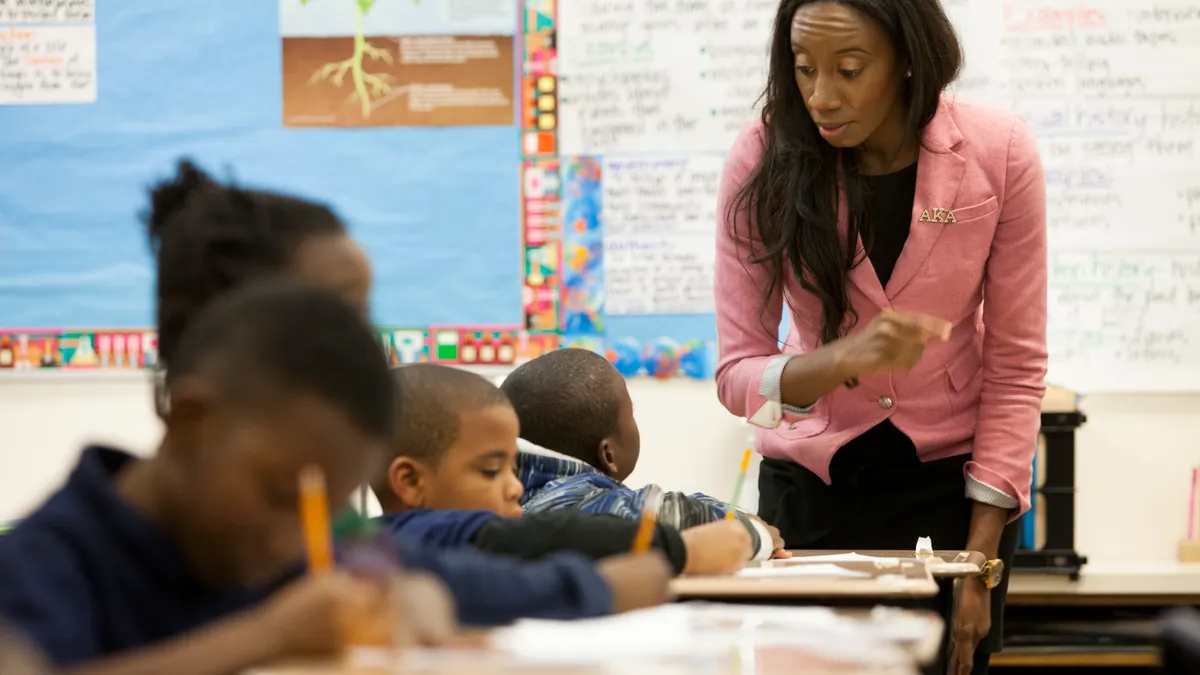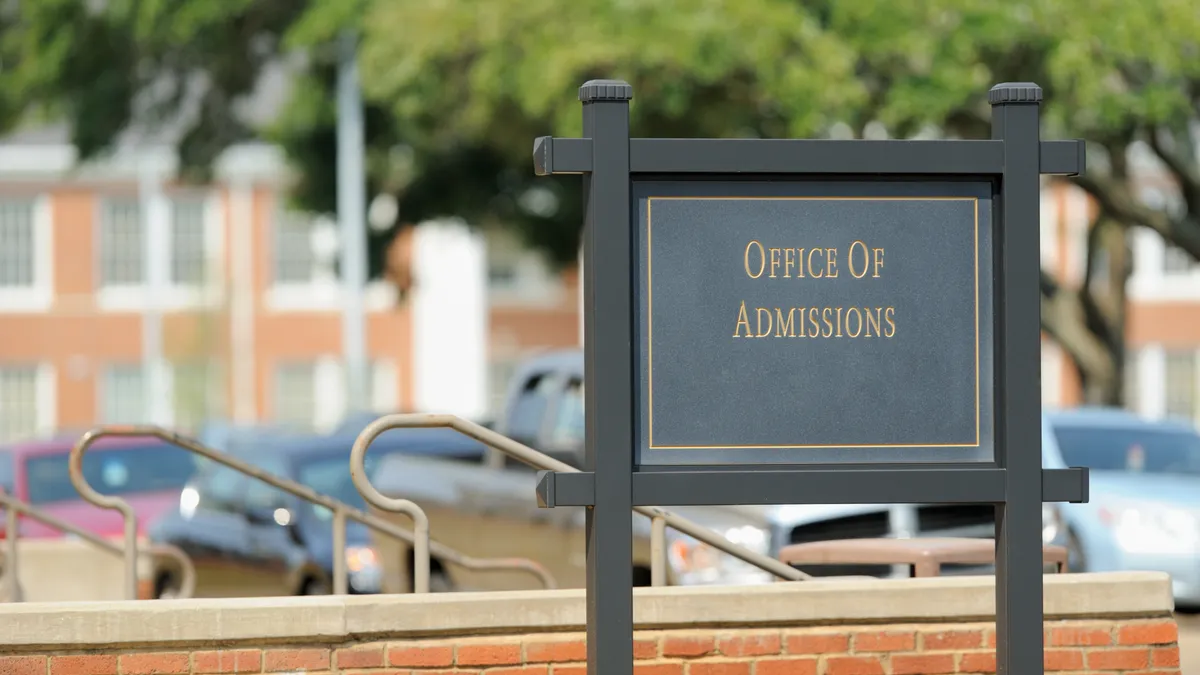Equity took center stage in the day two conversations at the Education Commission of the States National Forum on Education Policy Thursday. One resonant statement reflected how principal preparation programs didn't include equity components, meaning that now leaders are struggling to approach their work through an equity lens.
Western Interstate Commission for Higher Education President Joe Garcia — who shared with the audience that his school counselors never once mentioned to him the idea of his going to college— said working harder to close achievement gaps from early education on through to higher ed is everyone’s work.
“It’s not just an issue of racial justice — although that’s important — it’s a question of our economic sustainability” as a nation, Garcia said.
“Over one-half of the students now enrolled in K-12 [education across the country] are students of color,” Garcia said. “In Colorado, which many people often think of as being largely a white state, 46% of our population are of color.”
To put it a different way, he said,“Most of our current workforce is white, [but] most of our future workforce is of color — our current workforce is getting grayer, our future workforce is getting browner.”
“Most of our current workforce is white, [but] most of our future workforce is of color — our current workforce is getting grayer, our future workforce is getting browner.”
Joe Garcia
President, Western Interstate Commission for Higher Education
“What we know right now is there are about 6 million jobs that are vacant because of a lack of education and training for these jobs,” said Aaliyah Samuel, director of the education division at the National Governors Association. “What we know is that 75% of young adults right now do not qualify for the U.S. military or any of the armed services, because they’re either physically unable to enroll — they’re unhealthy — or they don’t meet the educational requirements. … If we don’t start paying attention to the populations that we historically have not paid attention to, then our United States will not have the workforce or the military that we need.”
The work begins way before kindergarten (and it doesn’t end after 12th grade)
Teresa Lubbers, commissioner of the Indiana Commission for Higher Education, said equity work “doesn’t start with quality preschool, as important as that is, or making sure everyone is graduating from high school, as important as that is. It is about [a] lifetime” commitment to making sure students from all backgrounds have the opportunities to access education at all levels.”
There has to be “full engagement at a much higher level [between educators,] employers and community leaders with an understanding that it is critically important to their communities that there can’t be anyone left behind,” Lubbers added.
“I think we have this clash a little bit between this permeating American ideal of opportunity for all with the reality that not everyone has” access to that opportunity, she continued. However, “there is no way to get to any of those attainment goals that we established by state … there’s no way to get there without making sure that we close the achievement gap.”
And Samuel said, “We need to start paying attention to the new population of students that are entering our schools, but also their families.”
“Kids aren’t just in school, and we know what happens in their communities and their homes really impacts [learning], so making sure they have equitable access across those systems” is key to supporting them as students and future citizens, she said.
“I don’t believe children are ‘at-risk,’ I believe they’re at-possibility, and it’s how we approach children and their families, it’s either we’re going to unlock those possibilities, or we’re going to” fail students and fail society, Samuel said.
“If we think about what is happening in [schools] across this country, there’s so much opportunity that can be available,” but we have to re-think our definition of equity, said Stephanie Wood-Garnett, who serves as a vice president with a "policy to practice" focus for the Alliance for Excellent Education. It’s about making sure that “not only are the resources available in every … school, but the supports may need to be weighted based on the” circumstances facing different students.
Margie Vandeven, Commissioner of Education for the Missouri Department of Elementary and Secondary Education, said, to put it plainly, “It’s as simple as a band-aid,” she said. “If Johnny needs a band-aid, you give Johnny a band-aid. You don’t give the entire class a band-aid, because Johnny needs a band-aid.”
It’s about looking at every individual child and identifying the needs of that child, finding a way to provide resources to each individual.
“Children who are in most need of those high quality environments are not getting that access,” Samuel said. “Children who need really high quality teachers are not having those experiences. What we know is that if a child has two or more years of an [ineffective] educational experience, they’re not going to reach that potential.”
But it’s important to recognize that student success is not always directly tied to educator effort.
“Sometimes when you’re in a low-performing district or school, people assume that you’re not operating at a high level as an educator” when students are not ending the year as proficient, said Wood-Garnett, who added focus has to be as much on a supportive environment for teachers which allows them an opportunity to grow as it is on student learning.
“We really need to be thinking about the school culture and climate, we need to be thinking about the level and types of education available to young people, because it is not the same,” she said. “And we need to be thinking about what kinds of messages young people are getting about how we value them” by way of the number of mentors, career and college services available, and the physical school environment — all of the things which will decide “whether or not the young people in those buildings believe we believe they can” achieve.
“I don’t know how to lead for equity, that was not part of my program to become principal.”
Professional development is perhaps the single most important aspect of the equity conversation.
Samuel pointed out that the question of the achievement gap is really one that is "directly tied to instructional bias — those low expectations" which even well-meaning educators project onto students of color.
With that in mind, equity conversations cannot focus solely on student access, but must also include conversations about professional development for teachers and administrators to ensure they're taking the right approach to educating students.
First of all, said Wood-Garnett, “You can’t have equity without inclusion.”
“It can be scary bc it’s hard to know how to best serve every different population,” she said. But “together we can do more to help young people to be successful.”
And for those struggling to identify where to start, she added, “diversity, equity and inclusion convos are happening across the nation. The nonprofit world, the philanthropic world, and even the conversations being had in your states” as officials prepare to enter the ESSA era are all available resources for school administrators to access.
But once those conversations begin to unfold, it is key that both administrators and “teachers are equipped with the skills that they need, and then students are exposed to rigorous content,” said Vandeven, who pointed out that a focus on professional development, coupled with an increase in rigor has led to “a tremendous increase in our AP scores, particularly with our African-American and Latino students” in Missouri.
And of course, representation matters. From teachers to administrators, Samuel said it is important to consider “How are we diversifying schools so that children not only see themselves, but we ensure that instructional bias is not there.”
Onus on higher ed to work together with K-12 system
“We have, quite frankly, a flattened high school graduate population,” Garcia said. And “the only way we’re going to fill the seats in our institutions is if we make sure that more students of color are graduating from high school with the skills they need to be successful.”
In many instances, he said, education is often viewed from a competitive framework — public four-year institutions compete against privates, and both compete against community colleges as resources and eligible recruitment pools dwindle. And all of higher ed is sometimes guilty of viewing K-12 with something of a disdain because elementary and secondary schools still dominate the public funding conversations.
But Garcia said, “We’re all in this together; we’re not just competing for limited resources … we all looked at it that way, in terms of competitors and not in terms of collaborators,” but now, collaboration across the educational enterprise is “critical to our ability to succeed in higher education.”
“For us, we need to know how well we’re doing in closing the achievement gap from early childhood education … all the way through,” Lubbers said. “We need to know in a very specific way how well we’re doing campus by campus in closing” those gaps. “We know that we’re making progress, but the gaps are significant still.”
Vandeven added she’s been “Very inspired by the shift in thinking of the school leaders, where they used to think about my kids in my district in trying to get that diploma, the conversation has now shifted to our kids and our future and are they going to be successful for the future.”






 Dive Awards
Dive Awards














